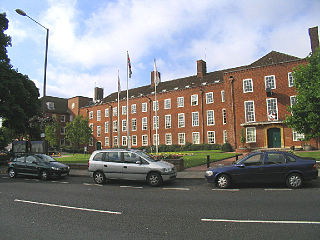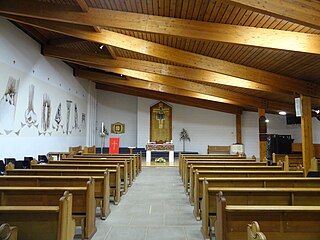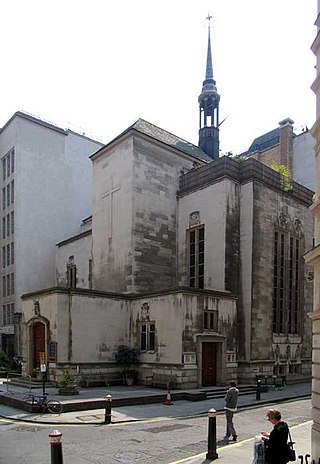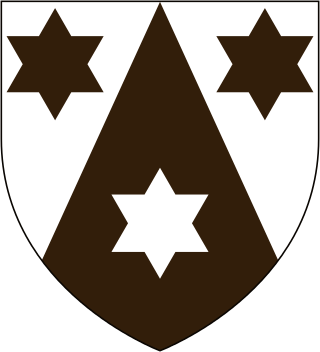
Thorndon Friars is a grade II listed building in Dury Road, Monken Hadley, London Borough of Barnet, England. The house dates from the early 1700s. [1]

Thorndon Friars is a grade II listed building in Dury Road, Monken Hadley, London Borough of Barnet, England. The house dates from the early 1700s. [1]

Friar Park is a Victorian neo-Gothic mansion in Henley-on-Thames, England, built in 1889. It was originally owned by eccentric lawyer Sir Frank Crisp and purchased in January 1970 by English rock musician and former Beatle George Harrison. The site covers about 62 acres. Features include caves, grottoes, underground passages, a multitude of garden gnomes, and an Alpine rock garden with a scale model of the Matterhorn. Though rumour and tabloid reports often claim the building has 120 rooms, this was denied by the current owner, Olivia Harrison, while speaking to NPR Fresh Air in March 2004, at which time she clarified the number was somewhere around 30.

The Borough of Brentwood is a local government district and borough in Essex in the East of England.

Blackfriars, Gloucester, England, founded about 1239, is one of the most complete surviving Dominican black friaries in England. Now owned by English Heritage and restored in 1960, it is currently leased to Gloucester City Council and used for weddings, concerts, exhibitions, guided tours, filming, educational events and private hires. The former church, since converted into a house, is a Grade I listed building.

St Bernardine's is the Roman Catholic Church in Buckingham, England. It is in the joint Parish of Buckingham and Brackley, together with St Martin's Catholic Church, Brackley.

The Dutch Church, Austin Friars, is a reformed church in the Broad Street Ward, in the City of London. Located on the site of the 13th-century Augustinian friary, the original building granted to Protestant refugees for their church services in 1550 was destroyed during the London Blitz.

Thorndon Hall is a Georgian Palladian country house within Thorndon Park, Ingrave, Essex, England, approximately two miles south of Brentwood and 25 miles (40 km) from central London.

St Dominic's Priory Church is one of the largest Catholic churches in London. The church is Grade II* listed building on the National Heritage List for England. It has been served by the Order of Preachers (Dominicans) since 1861, the community living in the adjacent Priory. In October 2016, the church was solemnly inaugurated by the Cardinal Archbishop of Westminster, Vincent Nichols, as a diocesan shrine, with a designated mission of promoting the Rosary.
Dunstable Friary was a Dominican friary in Dunstable, Bedfordshire, England. It was located to the west of Watling Street, between the present-day High Street South and the road that is called Friary Field.
Donnington Friary was a friary of crouched friars at Donnington in the English county of Berkshire. At the time of suppression the establishment was recorded as Trinitarian, but this was later corrected to Crossed Friars. This was possibly a ploy by the two brothers in occupation at the time in order to ensure their pension.

Whitefriars, also known as the White Friars or The College of Carmelites, Gloucester, England, was a Carmelite friary of which nothing now survives.

Aylesford Priory, or "The Friars" was founded in 1242 when members of the Carmelite order arrived in England from Mount Carmel in the Holy Land. Richard de Grey, a crusader, sponsored them, and conveyed to the order a parcel of land located on his manor in Aylesford in Kent. The estate came back into the ownership of the Carmelite order in 1949. After refurbishment, which revealed 15th century remnants, the manor house was Grade I listed in 1959. After subsequent work on site, the 15th century gatehouse and the NE section of the wall were also Grade I listed on 25 February 1987. The priory now contains an array of contemporary artworks by notable artists. It is a pilgrimage destination of national significance.

Boston Friary refers to any one of four friaries that existed in Boston, Lincolnshire, England.

In London, the Greyfriars was a Conventual Franciscan friary that existed from 1225 to 1538 on a site at the North-West of the City of London by Newgate in the parish of St Nicholas in the Shambles. It was the second Franciscan religious house to be founded in the country. The establishment included a conventual church that was one of the largest in London; a studium or regional university; and an extensive library of logical and theological texts. It was an important intellectual centre in the early fourteenth century, rivalled only by Oxford University in status. Members of the community at that time included William of Ockham, Walter Chatton and Adam Wodeham. It flourished in the fourteenth and fifteenth century but was dissolved in 1538 at the instigation of Henry VIII as part of the Dissolution of the Monasteries. Christ's Hospital was founded in the old conventual buildings, and the church was rebuilt completely by Sir Christopher Wren as Christ Church Greyfriars after the original church was almost completely destroyed in the Great Fire of London of 1666. The building now standing on the site, designed by Arup Group Limited, is currently occupied by Merrill Lynch.
Delaware v. City of Westminster is an English court ruling on nuisance, addressing the question of liability for repairing damage caused by tree roots. The court upheld a ruling of the Court of Appeal, stating that if a defendant knew about a continuing nuisance, and had been given notice and opportunity to deal with it but failed to do so, then a claimant was entitled to receive costs for removing the nuisance themselves. It is a leading case in the Law of Nuisance, Trees and Forestry.

The Blackfriar is a Grade II* listed public house on Queen Victoria Street in Blackfriars, London.

Apothecaries Hall is a scheduled monument at Black Friars Lane, London. It is the headquarters of the Worshipful Society of Apothecaries of London, one of the livery companies of the City of London. It is one of the largest livery companies and ranks 58th in their order of precedence. The building, originally part of the Dominican priory of Black Friars, was called Cobham House prior to its purchase by the society in 1632.

The statue of Queen Victoria stands at the western end of Friar Street outside the Town Hall of Reading, Berkshire, in southern England.

Thorndon Park is a 141.4-hectare (349-acre) biological Site of Special Scientific Interest in Brentwood in Essex. Part of it is run by Essex County Council as Thorndon Country Park, and the Essex Wildlife Trust manages its visitor centre.

Hitchin Priory in Hitchin in Hertfordshire is today a hotel built in about 1700 on the site of a Carmelite friary founded in 1317, which was closed in the Dissolution of the Monasteries during the reign of Henry VIII. Parts of the original priory are incorporated in the existing building, which has been a Grade I listed building on the Register of Historic England since 1951.
![]() Media related to Thorndon Friars at Wikimedia Commons
Media related to Thorndon Friars at Wikimedia Commons
Coordinates: 51°39′46″N0°11′53″W / 51.66282°N 0.19804°W